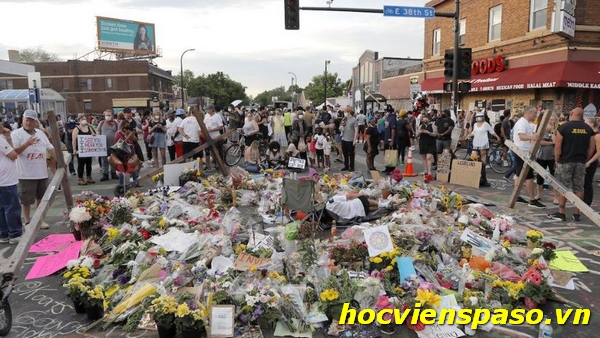George Floyd Bodycam Footage: The video is made public

During the controversy surrounding the George Floyd case, a video from a police body camera attracted widespread attention. This video, called “George Floyd Bodycam Footage,” is claimed to “completely change the narrative.” However, is this true? In this article, hocvienspaso.vn will explore the truth about this body camera video, emphasizing its release time and its impact on the George Floyd case.
I. History of police body camera video release in the George Floyd case
Following the tragic incident involving George Floyd, the release of police body camera footage has played an important role in shedding light on the events leading to his death. The timeline of when these videos were made public and how the public gained access to them is an important aspect of understanding transparency and accountability in this case.
1. May 25, 2020: Tragedy
– On May 25, 2020, George Floyd was tragically killed in Minneapolis after former police officer Derek Chauvin knelt on his neck for several minutes during an arrest.
2. First video
– Immediately after the death of George Floyd, bystander cell phone and security camera video from nearby buildings became pivotal in reconstructing the events leading up to the incident. These videos were widely circulated on social networks and news outlets, causing outrage and protests.

3. May 27, 2020: Launch of the first body camera
– On May 27, 2020, the Minneapolis Park Police Department released redacted “George Floyd Bodycam Footage” related to the incident. However, this video is limited in scope and does not provide a complete account of the events.
4. July 8, 2020: Transcript of Lane’s body camera footage
– A breakthrough occurred on July 8, 2020, when the recording of an officer’s body camera footage, specifically that of Thomas Lane, was made public. This comes after Lane’s attorney filed a motion to dismiss the charges against him.
5. July 13, 2020: Public Access Required
– On July 13, 2020, a coalition of news organizations formally requested public access to body camera footage. This marks an important step in the effort to bring video to a wider public.
6. July 15, 2020: Limited viewing
– Two days later, July 15, 2020, media agencies and citizens were allowed to view body camera footage but only by appointment. Footage cannot be copied or recorded during these viewings.
7. August 3, 2020: Transcript leaked
– In early August 2020, leaked body camera recordings, including videos shown by Megyn Kelly in November 2021, became available to the public. This leak raises questions about the delayed release of the footage.
8. August 10, 2020: Official launch
– Finally, on August 10, 2020, the Minneapolis Police Department officially released the body camera footage to the public. This marked the culmination of efforts to popularize the videos.
It’s important to note that the body camera footage shown by Megyn Kelly in November 2021 was in the public domain more than a year before her presentation. Although she described it as “new,” the footage was key evidence in Derek Chauvin’s March 2021 trial, which led to his conviction for second-degree murder .
Understanding the timeline for the release of body camera footage is critical in assessing transparency and accountability surrounding the George Floyd case.
II. Body Camera video content: George Floyd’s interaction with the Police
Body camera footage became key evidence in the George Floyd case providing a detailed account of the interactions between George Floyd and the police officers involved. This part will delve into the video content, clarifying the situation and events that took place during that fateful meeting.
1. Initial interaction:
– George Floyd Bodycam Footage: begins with police Thomas Lane and Alexander Kueng approaching the car where George Floyd is sitting. Lane used his baton to knock on the car window and asked to see both of Floyd’s hands.
2. Floyd’s response:
– George Floyd seemed startled and repeatedly said, “I’m sorry” when opening the car door. This initial interaction may seem tense but not overly aggressive.
3. Drawing a gun:
– Just seconds after opening the car door, Officer Lane pulled out his gun and pointed it at George Floyd. This escalation significantly increased tension and caused Floyd to react with fear and anxiety.
4. Floyd’s plea:
– When Officer Lane pointed his gun at him, George Floyd begged the officer, “Please don’t shoot me.” Floyd’s fear and suffering were evident in this moment, recorded by the body camera.
5. Powerful removal:
– Body camera footage shows several cuts, indicating moments under editing. After one such cut, Officer Lane can be heard repeatedly asking Floyd to step out of the car. Floyd continued to plead: “Please don’t shoot me.” After another cut, Lane forced George Floyd out of the car.
6. Events leading up to the arrest:
– Body camera video provides a chronological account of the events leading up to George Floyd’s arrest. It captured the increasing tension and fear in Floyd’s voice as he interacted with the officers.

It is important to note that body camera footage was key evidence in the trial of Derek Chauvin, the former police officer who knelt on George Floyd’s neck. While opinions vary as to whether this video “completely changes the narrative,” as some have suggested, it undeniably gives a first-hand perspective of the encounter between George Floyd and the police on that tragic day in May 2020.
The content of body camera video has played an important role in shaping public perception and understanding of the events leading to George Floyd’s death, and it continues to be a focal point in discussions. debate around police accountability and reform.
III. Megyn Kelly’s statement: Changing the narrative with body cam video
Megyn Kelly, renowned journalist and host of “The Megyn Kelly Show” on SiriusXM podcast, has made an important statement regarding the police body camera video related to the arrest of George Floyd. In her statement, Kelly asserted that this video has the ability to “completely change the narrative” surrounding the George Floyd case.
On her show, which aired on November 15, Kelly interviewed Liz Collin, producer, and JC Chaix, director of a new documentary titled “The Fall of Minneapolis.” This documentary aims to shed light on what really happened the day George Floyd died and delve into the events leading up to that tragic incident.
During the interview, a significant portion of body camera video was shown, showing the interaction between George Floyd and officers Thomas Lane and Alexander Kueng. The clip shows Officer Lane approaching the car, using his baton to knock on the window, and asking to see both of Floyd’s hands. It also captures George Floyd’s startled reaction and his repeated apologies.
However, the video’s key moment occurs when Officer Lane pulls out his gun and points it at George Floyd, causing Floyd to beg, “Please don’t shoot me.” George Floyd Bodycam Footage: depicts the tension and fear in Floyd’s voice and attitude during this confrontation.
Megyn Kelly’s assertion that this body camera video has the ability to “completely change the narrative” suggests that she believes it can change public perception of the George Floyd case. Although the video has been publicly available since August 2020, Kelly’s decision to feature it on the show has drawn new attention to its content.
It’s important to note that opinions on whether this video actually changes the narrative may vary. However, body camera footage remains an important piece of evidence that provides unique insights into the encounter between George Floyd and police officers, contributing to the ongoing discussions. issues about justice, accountability, and policing in America.
IV. Public Response and Impact
The release of the George Floyd body camera video stirred various public reactions and discussions. Here’s a brief summary:
Police Accountability Advocates: Those pushing for police accountability saw the video as crucial evidence, emphasizing transparency, justice, and reforms.
Concerns about Excessive Force: The video raised concerns about excessive force, prompting discussions on officer training and de-escalation techniques.
Impact on Public Perception: Megyn Kelly’s statement about changing the narrative sparked debate, but its lasting impact remained uncertain.
Legal Implications: Legal experts debated whether the video would influence legal proceedings, given that it was already shown in Derek Chauvin’s trial.
Protests Reignited: The video reignited protests for racial justice and police reform.
Media Ethics Scrutinized: Critics questioned the ethics of presenting old footage as “new,” highlighting responsible journalism concerns.
In summary, the video’s release fueled discussions on police accountability, excessive force, legal proceedings, protests, and media ethics. It remains a focal point in the ongoing dialogue on justice and equality.
V. Reminder through this incident
In summary, while Megyn Kelly’s statement about “new” body camera video may have attracted attention, it must be emphasized that this footage has been publicly available since August 2020 Furthermore, it played a key role in the trial of Derek Chauvin, ultimately leading to his conviction.
The release of George Floyd’s body camera video has sparked important discussions about police accountability, excessive force, due process, protests and media ethics. It remains an important piece of evidence in the ongoing dialogue about justice and equality in America.
This case serves as a reminder of the power of transparency and the impact of visual evidence in shaping public perception and influencing the course of justice.









